
The Southern Pacific was an American Class I railroad network that existed from 1865 to 1996 and operated largely in the Western United States. The system was operated by various companies under the names Southern Pacific Railroad, Southern Pacific Company and Southern Pacific Transportation Company.

The GE U25B is General Electric's first independent entry into the United States domestic road switcher diesel-electric locomotive railroad market for heavy production road locomotives since 1936. From 1940 through 1953, GE participated in a design, production, and marketing consortium (Alco-GE) for diesel-electric locomotives with the American Locomotive Company. In 1956 the GE Universal Series of diesel locomotives was founded for the export market. The U25B was the first attempt at the domestic market since its termination of the consortium agreement with Alco.

The California State Railroad Museum is a museum in the California State Parks system that interprets the role of railroads in the West. It is located in Old Sacramento State Historic Park at 111 I Street, Sacramento, California.
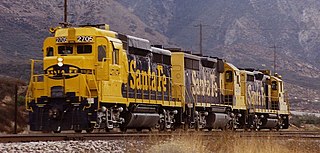
The EMD GP30 is a 2,250 hp (1,680 kW) four-axle diesel-electric locomotive built by General Motors Electro-Motive Division of La Grange, Illinois between July 1961 and November 1963. A total of 948 units were built for railroads in the United States and Canada, including 40 cabless B units for the Union Pacific Railroad.

The EMD F7 is a model of 1,500-horsepower (1,100 kW) diesel-electric locomotive produced between February 1949 and December 1953 by the Electro-Motive Division of General Motors (EMD) and General Motors Diesel (GMD).

The EMD SW1 is a 600-horsepower (450 kW) diesel-electric switcher locomotive built by General Motors' Electro-Motive Corporation between December 1938 and November 1953. Final assembly was at EMD's plant at LaGrange (McCook) Illinois. The SW1 was the second generation of 3,402 cu in (55.75 L) switcher from EMD, succeeding the SC and SW. The most significant change from those earlier models was the use of an engine of EMD's own design, the then-new 567 engine, here in 600 hp (450 kW) V6 form. 661 locomotives of this design were built, with a gap in production between March 1943 and September 1945 due to World War II.

The EMD GP9 is a four-axle diesel-electric locomotive built by General Motors' Electro-Motive Division between 1954 and 1959. The GP9 succeeded the GP7 as the second model of EMD's General Purpose (GP) line, incorporating a new sixteen-cylinder engine which generated 1,750 horsepower (1.30 MW). This locomotive type was offered both with and without control cabs; locomotives built without control cabs were called GP9B locomotives.
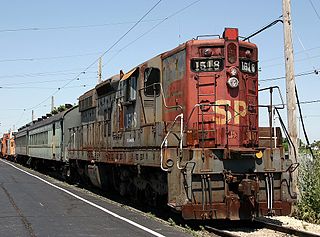
The EMDSD7 is a model of 6-axle diesel locomotive built by General Motors Electro-Motive Division between May 1951 and November 1953. It had an EMD 567B 16-cylinder engine producing 1,500 horsepower (1.12 MW) for its six traction motors. United States railroads bought 188 units.

The EMD SD9 is a model of diesel locomotive built by General Motors Electro-Motive Division between January 1954 and June 1959. An EMD 567C 16-cylinder engine generated 1,750 horsepower (1.30 MW). Externally similar to its predecessor, the SD7, the SD9 was built with the improved and much more maintainable 567C engine.

The SD45 is a six-axle diesel-electric locomotive class built by General Motors Electro-Motive Division between 1965 and 1971. It has an EMD 645E3 twenty-cylinder engine generating 3,600 hp (2,680 kW) on the same frame as the SD38, SD39, SD40, and SDP40. As of 2023, most SD45s have been retired, scrapped or rebuilt to SD40-2 standards.

The Western Pacific Railroad Museum (WPRM) in Portola, California, known as the Portola Railroad Museum until January 1, 2006, is a heritage railroad that preserves and operates historic American railroad equipment and preserves documents, photos and information. The museum's mission is to preserve the history of the Western Pacific Railroad and is operated by the Feather River Rail Society, founded in 1983. It is located at a former Western Pacific locomotive facility, adjacent to the Union Pacific's former Western Pacific mainline through the Feather River Canyon.
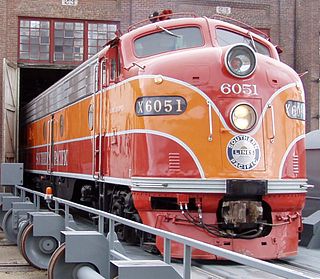
Southern Pacific 6051 is an EMD E9 diesel locomotive. It was one of nine E9s built for SP by EMD in December 1954 for the Southern Pacific (SP).
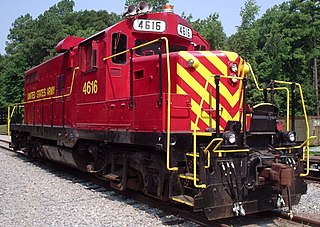
The EMD GP10 is a diesel-electric locomotive that is the result of rebuilding a GP7, GP9 or GP18.

The Museum of the American Railroad, formerly known as the Age of Steam Railroad Museum, is a railroad museum in Frisco, Texas. The museum has more than 70 pieces of steam, diesel, passenger, and freight railroad equipment sitting on 15 acres making it one of the largest historic rail collections in the US. Guests may walk through some of the equipment on guided tours.
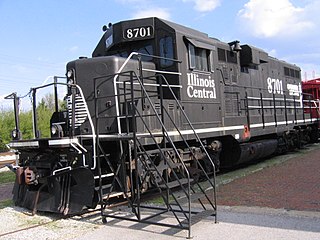
The EMD GP11 is a four-axle diesel locomotive rebuilt by the Illinois Central Railroad's Paducah shops. It is very similar in appearance to the GP8 and GP10.

The Krauss-Maffei ML 4000 is a road switcher diesel-hydraulic locomotive, built between 1961 and 1969 by German manufacturer Krauss-Maffei in Munich, Germany. It generated 3,540 horsepower (2,640 kW) from two Maybach V16 engines. 37 examples were built for two North American railroads and one South American railroad.

Southern Pacific No. 1744 is a preserved American class "M-6" 2-6-0 "Mogul" type steam locomotive built by the Baldwin Locomotive Works for the Southern Pacific Railroad in November 1901. Originally equipped with Vauclain compound cylinders, it was rebuilt with conventional cylinders in 1912. It operated for many years out of Oakland, California on the Southern Pacific's Western Division and in California's Central Valley where the locomotive and its classmates were fondly called “Valley Mallets” by their crews. The locomotive was made famous in later years by pulling some of the last steam excursions on the SP alongside other steam locomotives, including 4-8-4 4460. In 1959, No. 1744 was donated to the Sons of Utah Pioneers in Corinne, Utah where it remained on static display, until 1980. That year, it was restored by New London Railroad and Village Incorporated to operate on the Heber Valley Railroad in Heber City for the rest of the decade.

The EMD SD9E was a rebuild from EMD SD9 diesel locomotives that were built by General-Motors Electro-Motive Division for the Southern Pacific Transportation Company.

The EMD SD7R was a rebuild from EMD SD7 diesel locomotives that were built by General-Motors Electro-Motive Division for the Southern Pacific Transportation Company.

The EMD GP9R was a rebuild from EMD GP9 diesel locomotives that were rebuilt by the Chicago and North Western Transportation Company, Grand Trunk Western Railroad, Southern Pacific Transportation Company.
























